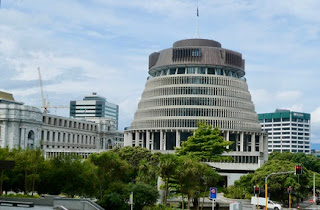Today, we visited Zealandia in Wellington, a 225 hectare (500+ acre) eco-sanctuary, which represents a groundbreaking conservation project that has reintroduced 18 species of native wildlife back into the area, some of which were previously absent from mainland New Zealand for over 100 years. Zealandia is the world’s first fully-fenced urban reserve, with an extraordinary 500-year vision to restore a Wellington valley’s forest and freshwater ecosystems as closely as possible to their pre-human state.
But first, we had breakfast at Floriditas, featuring "green eggs and ham."
Our hotel, The Mercure City Center, is the tall, teal and purple building in the middle. We are on the ninth floor, (each floor has only 3 rooms.
Down at street level, this is a Wellington manhole cover.
After breakfast, we all gathered and walked through the city to a cable car station. For NZ$ 6 apiece, we rose about just short of 400 feet vertical along a straight path of 2,000 feet. It is a single car and smoothly glides upward passing a sister car coming down. It is on a single track except for short middle section where the cars pass each other. This is the view back down to Wellington from the upper station. The day started with low clouds and high humidity, but never rained.
A poster of the indigenous birds of NZ that are present within the sanctuary.
Zealandia is actually a continent formed by the up-lifting of land at the junction between two tectonic plates. Most of the continent is under water - the areas in white are above water and this map clearly shows the two islands of NZ. The fault line is also clearly delineated. It is along this line that earthquakes occur regularly.
We were guided by Paul, a volunteer for Zealandia, on a two-hour walk around the lower quadrant of the sanctuary. Obviously he was our birdlife spotter and very good at identifying bird calls. The sanctuary has a pair of these takahe that are at least 20 years old. They produced a number of chicks in their earlier years.
This is a tiny orchid that lives symbiotically with the forest floor fungi. It is not a great photo since it is so small, and the flowering is past. It was called a potato orchid, because the Maori considered the below-ground tubers to be edible.
One of many interesting looking fungi growing on a tree.
Bird's nest fungi - it is about the a dime size across, and note the "eggs."
The best shot I got of a Kaka in the trees, a large parrot.
This is Toutouwai, or a North Island Robin
Another Kaka, near a feeding platform.
There are two dams in the narrow valley comprising the sanctuary. This shows the upper reservoir, which is kept at 1 meter in depth, as a safety precaution to prevent a catastrophic flood downstream if an earthquake damaged the dam structure. The former sides of the reservoir were planted with native vegetation which is visible in this picture. The tall pine trees in the background are Monterey Pines planted when the dams were built and the reservoirs filled over a hundred years ago. The reservoir system was part of the domestic water supply for Wellington, from 1873 until 1991.
There is a special enclosure for Tuataras, rare, medium-sized reptiles considered a "living fossil."
Tui, with a small white dewlap on its chin.
Another Tuatara, looks like an iguana.
The valley is named Karori.
After leaving Zealandia, we had snacks at the Cable Car Cafe, then walked downhill through Wellington's Botanical Garden and back to the hotel.
Agaves in bloom.
The rose garden and metal 'trees'
We emerged from the garden in our descent and came out by the "Beehive, " the ministerial building adjacent to the Parliament Building, which includes the Prime Minister's Office. Most other MPs have offices in traditional stone buildings, just to the left. You might be able to see the upper part of the sky bridge that connects the offices with the meeting space within the Beehive.
We ended up walking over 7 miles, and spent a couple of hours in our respective rooms to rest.
For dinner, we went out for Malaysian food but the first restaurant was packed (all 6 tables), so we went further afield, up Cuba Street and found the Satay Palace. It clearly was a family-run place, not much bigger than the first one, but they shifted tables around to accommodate seven people. They had an extensive menu and the food was great. Mom was the wait staff, Grandma and Dad were the chefs, Granddad helped move tables and the like, and 2 sons (maybe 2 and 4 years old) ran around but stayed out of trouble. After dinner, we strolled down the length of Cuba Street, looking at the old building fronts, and doing a little people watching. We called it night since we have to get to the train station to catch an early train to Auckland.
























Looks like another educational and fun day. Claire
ReplyDeleteThat's my idea of a fun day (except maybe the seven-mile part, which my knees might not consider so fun!).
ReplyDeleteYou describe everything so wonderful that i feel i'm there too ! JR
ReplyDelete